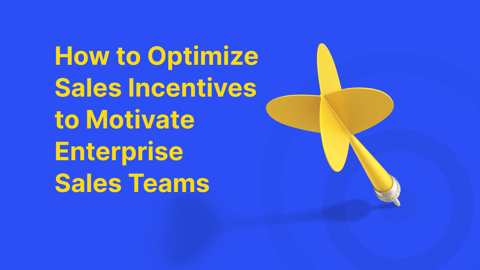Ask any person working in sales, and they’ll tell you it’s like no other job. People in finance, marketing, operations, or distribution can often plan their work days or weeks ahead.
Salespeople have to adapt and change constantly. As their prospects move through the sales funnel, they often change their requirements and needs as they better understand their problems and the options open to them. So, while sales managers and salespeople will have a plan at the beginning of every quarter and every year, you can be sure that by the end, that plan will have changed multiple times as some deals close and others fall away.
For a sales team, this is just a normal part of life, but at the end of every quarter or every year, the sales team often needs to regroup and refocus. How do managers rebuild the sales motivation they need to be successful? What’s the best way to motivate a sales team when sales are down? How do you maintain this motivation and focus when your sales team has been successful?
The same issues might also be important after a merger or a significant business restructuring project when it’s easy for salespeople to become distracted.
All these issues matter because motivation is key to building profitable revenue growth.
Let’s look at some ideas to get your sales team on track and focused on their next big challenge.
Leverage Real-time Commission Tracking
Sales quotas are challenging – they’re meant to be, and no one said that life in sales would be easy. Challenging quotas help build the business and cover the cost of all its investments, not just its sales and marketing costs.
At the beginning of the sales year, everyone should feel slightly uneasy at the number they’ve been handed. It’s the same for everyone, from the VP of Sales down to the newest Account Manager.
That said, you can do several things to help your sales team make this number more digestible.
Firstly, break down this number into smaller chunks, whether weekly, monthly, or quarterly targets, and have each salesperson create their mini-sales plan to help them hit their number. In fairness, most salespeople will do this, or at least something similar, so here’s another trick.
In Adam Alter’s book, Irresistible, he explains how having a real-time commission tracking capability taps into a deep-seated need to hit targets and how best to harness this motivation. By giving real-time commission tracking software to your sales team, their motivation to hit quotas will remain high because they can see their progress quickly and easily as they book business. They can then plan their time effectively to hit their remaining target. It can show them if they’re entitled to any special bonuses, and it helps them structure the deals that benefit themselves – and, therefore, the business – the most. Automating these processes allows them to focus on building their pipeline and closing deals.
Set Short-Term Targets
Many people will already recognize that targets with a deadline in the short term are perceived as more transparent and defined than targets further out. When a target is more precise (and closer), our brains begin to translate these targets into tactics. There’s even a name for this phenomenon: the construal-level theory of psychological distance.
We’ve already touched on how salespeople can use this idea to break down their target into more manageable chunks. Sales managers can do the same at a more elevated level by introducing a series of sales incentives, in addition to the standard commission plan, to keep salespeople focused and motivated.
This might be additional bonuses paid on businesses closed earlier in the year or a team night out for the best-performing team in a quarter. A team social event based on overall sales team performance may also do the trick. Special bonuses and SPIFFs throughout the year, over and above the standard sales incentive plan, can keep salespeople motivated, focused, and effective as well.
Plan to Do Better Next Time
Another concept in the construal-level theory is experiential distance. As time passes, you and your sales team reflect on and rationalize what worked and what didn’t over the last 12 months.
One way to keep your sales team focused and motivated is to consider their ideas and feedback as you make your sales plan for next year. This is good to a point, but remember that everyone’s perspective will be different and even partial or flawed.
The alternative is to use actual sales and marketing data analytics to determine what worked and what didn’t in the sales year, especially when comparing the performance of your best performers with the rest of your sales team.
Learn how long deals were in the pipeline and who had the shortest sales cycles. Identify how many touchpoints are needed to close the most significant values. See where discounts or special promotions worked most effectively.
Understand these insights – and many more – to see where you can improve the productivity of your sales team. What do you need to do to grow your business by 50%? How many more leads do you need, and where might you get them? Might a sales development representative (SDR) team help boost sales effectiveness? How might changes to your sales incentive model make the most significant impact?
Learning the lessons of the last 12 months can help you understand how to plan for success over the next 12.
Use Your Sales Data as a Coaching Tool
As we touched on earlier, understanding the reasons behind the success of your top people can help you coach those who are less successful.
Use your sales and marketing data to get valuable pointers in one-to-one coaching sessions or your sales training material and sessions. These can be invaluable in providing sales motivation.
What issue might be significant?
- Were your salespeople effective because they called right across the business with relevant and compelling propositions (in which case, what were they?)
- Did they find the one person in the business who could be the compelling evangelist for their proposal (so-called Finding the Fox)? Again, in which case, what problems were they seeking to solve, and what was so compelling about their offer?
- Was the difference in their performance down to high call or meeting volumes?
- Was it a solution-selling approach to working with customers rather than just pitching a product?
- Was having a deep level of industry insight a critical success factor, in which case, how do you best broaden the expertise throughout the sales team?
Sifting all this evidence is far from easy, but using automated tools that provide insight can take a long way to ensure your sales team is successful. Leverage all that sales, marketing, and customer data, and find out – objectively – why your most successful people are so successful. It might be that the recipe for success lies within several people and that even your best people can learn from each other.
Leverage your sales data to identify, coach, and reward the right behaviors based on how your customers buy, not how your salespeople want to sell to them. Use this insight to motivate your salespeople for your upcoming sales campaigns.
Plan for Success
The single most important success factor in motivating a sales team at the beginning of the sales year is to have a well-planned sales plan that maximizes the chances of success for everyone.
While some managers may view letting the ‘cream rise to the top’ as an effective way to manage their team, this approach can have drawbacks. As well as having top performers potentially sitting on their laurels, those further down the ladder of success will be doing everything they can to close business. This may result in customer interactions that harm customer and prospect relationships, whether offering unsuitable products, imposing unreasonable contract terms, or using aggressive sales tactics.
An alternative is to take a more systematic approach. Here, you build the sales team – including its territories, quotas, and incentive plans – around the market opportunity based on a realistic assessment of the addressable market – which may be larger than you think. It may be that there are niches and new addressable markets that you can engage with tweaks to your offer or by creating a specific proposition.
However you approach this, the ideal situation is where both the sales and marketing functions have the same view of the addressable market, whether it covers a specific sector, region, country, or target demographic. This is harder than it sounds, as companies are constantly growing, merging, or forming, so understanding who might be a good prospect for your sales team will change regularly.
With this in place, you can understand how your territory plan might work. You want to ensure that each territory has a similar opportunity for all your sales reps so all the territories are equally well-served. You want to avoid having too many agents chasing the same business in one territory or territories where your representatives can only cover some of the opportunities and leads they’re given.
With your territories defined based on opportunity, you can start to design your sales quota model for your team. These’ll be based on the size of your addressable market, the potential in each territory, and the business’s financial needs. You may want to create multiple options to see how different mixes of quota and territory models generate different outcomes based on accurate data from your finance, sales, and marketing platforms. You can use your territory and quota models to help you design the sales incentive models that’ll get you the results your business needs. Again, you can balance different commission models, base salary and commission mixes, and other incentives that’ll motivate your sales team.
With your final selection in place, you can take your sales team through the plan and explain how it was worked out, creating the crucial buy-in you need to motivate your salespeople. You can also share your plan with other business functions, like operations or logistics, so they can make their own plans and investments based on the likely demands based on this analysis.
Learn how to develop sales plans using deep market insights to motivate sales team and maximize your opportunity to grow with our eBook, The Complete Guide to Sales Planning eBook.




